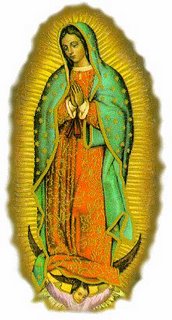Today the Church in the United States celebrates the optional memorial of St. Juan Diego, an Indian convert, to whom the Virgin Mary appeared as he was going to Mass in Tlatlelolco, Mexico. Our Lady asked him to tell the Bishop that she desired a shrine to be built on the spot to manifest her love for all mankind. She left a marvelous portrait of herself on the mantle of Juan Diego as a sign for the Bishop. This miraculous image has proved to be ageless, and is kept in the shrine built in her honor, the Basilica of Our Lady of Guadalupe, Patroness of the Americas.
Click through on the link to read more, see prayers, activities, and lots of good stuff.
I really love Our Lady of Guadalupe but hadn't ever stopped to think about her humble servant, Juan Diego. When I do I can see parallels to my own life, as removed as it may seem from his so long ago and in such different circumstances. One of my favorite parts of the story involves Juan Diego having a problem that makes him miss his appointment with Mary.
By Monday, December 11, however, Juan Diego's uncle Juan Bernardino had fallen sick and Juan Diego was obliged to attend to him. In the very early hours of Tuesday, December 12, Juan Bernardino's condition having deteriorated overnight, Juan Diego set out to Tlatelolco to get a priest to hear Juan Bernardino's confession and minister to him on his death-bed. Fourth apparition: in order to avoid being delayed by the Virgin and embarrassed at having failed to meet her on the Monday as agreed, Juan Diego chose another route around the hill, but the Virgin intercepted him and asked where he was going; Juan Diego explained what had happened and the Virgin gently chided him for not having had recourse to her. In the words which have become the most famous phrase of the Guadalupe event and are inscribed over the main entrance to the Basilica of Guadalupe, she asked: "¿No estoy yo aquí que soy tu madre?" ("Am I not here, I who am your mother?"). She assured him that Juan Bernardino had now recovered and she told him to climb the hill and collect flowers growing there. Obeying her, Juan Diego found an abundance of flowers unseasonably in bloom on the rocky outcrop where only cactus and scrub normally grew. Using his open mantle as a sack (with the ends still tied around his neck) he returned to the Virgin; she re-arranged the flowers and told him to take them to the bishop. On gaining admission to the bishop in Mexico City later that day, Juan Diego opened his mantle, the flowers poured to the floor, and the bishop saw they had left on the mantle an imprint of the Virgin's image which he immediately venerated.
I love that in order to avoid delays and embarrassment, Juan Diego goes a different way. I have way too many times in my life like that. Though I rarely have such a good excuse as caring for an ill relative. And the fact that Mary chides him for not turning to her with his problem is a good reminder that too often I forget to enlist God's help in the challenges in my life.
We are trying to celebrate saint days more intentionally in our lives. So we will get some special roses, have Oh Gosh cocktails (like a margarita but made with rum — can't help it that we don't like tequila, we do the best we can!) .












